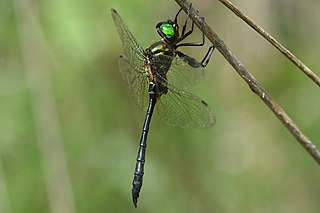
The Corduliidae, also knowns as the emeralds, emerald dragonflies or green-eyed skimmers, is a family of dragonflies. These dragonflies are usually black or dark brown with areas of metallic green or yellow, and most of them have large, emerald-green eyes. The larvae are black, hairy-looking, and usually semiaquatic. This family include species called "baskettails", "emeralds", "sundragons", "shadowdragons", and "boghaunters". They are not uncommon and are found nearly worldwide, but some individual species are quite rare. Hine's emerald dragonfly, for example, is an endangered species in the United States.

Erythemis is a genus of dragonflies in the Libellulidae family, commonly known as pondhawks. These medium- to large-sized skimmers are voracious predators of other insects up to their own size, including other dragonflies.

Boyeria is a genus of dragonfly in the family Aeshnidae, commonly called spotted darners. They occur in temperate North America and Eurasia.
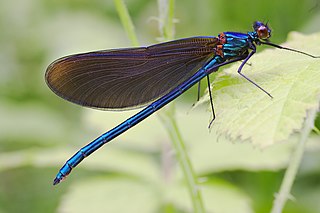
Calopteryx is a genus of large damselflies belonging to the family Calopterygidae. The colourful males often have coloured wings whereas the more muted females usually have clear wings although some develop male (androchrome) wing characteristics. In both sexes, there is no pterostigma.

Cordulegaster is a genus of dragonfly in the family Cordulegastridae. It contains the following species:

Erpetogomphus is a genus of dragonfly in the family Gomphidae. They are commonly known as ringtails. Most of the species are predominantly green coloured and the males have a moderately clubbed tail. A fossil species is known from the Miocene Mexican amber

Ictinogomphus is a genus of dragonflies in either the family Gomphidae or Lindeniidae. They are medium to large, yellow and black with clear wings. Species occur in Africa, Asia and Australia.
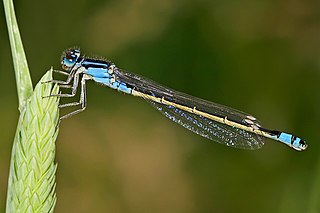
Ischnura is a genus of damselflies known as forktails in the family Coenagrionidae. Forktails are distributed worldwide, including various oceanic islands. The males have a forked projection at the tip of the abdomen which gives the group their common name.

Leucorrhinia is a genus of dragonfly in the family Libellulidae. They are commonly called whitefaces because of their distinctive pale frons.

Ophiogomphus, the snaketails, is a genus of dragonfly in the family Gomphidae. The species mostly have beautifully marked green club-shaped abdomens, more noticeable in the males.

Cordulia is a genus of dragonfly in the family Corduliidae.

Epitheca is a genus of dragonflies in the family Corduliidae. They are commonly known as baskettails.

Arigomphus is a genus of dragonflies of the Gomphidae family. This group is commonly called the pond clubtails. The species are fairly plain and only the males have the club-shaped abdomen. Unlike other gomphids, they may emerge from artificial ponds.
Lanthus is a genus of club-tailed dragonflies found in North America, commonly called pygmy clubtails. They are found in Japan and North America. The species are clear winged with black bodies and yellow markings.

Aphylla is a widespread Neotropical genus of dragonflies of the Gomphidae family. They are commonly known as the greater forceptails because of their forceps-like cerci.

Diphlebiidae is no longer recognised as a biological family. It was the name given to a small family of damselflies, the azure damselflies, with species in two genera: Diphlebia and Philoganga. Diphlebia is found in Australia and Philoganga is found in Southeast Asia. They are large and thick-bodied damselflies. They rest with their wings spread out. The Diphlebiidae were also known as Philogangidae.
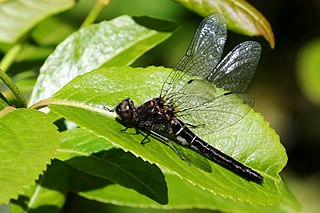
Williamsonia is a genus of small dragonflies in the family Corduliidae. They are commonly known as boghaunters. Unlike other genera of emerald dragonflies, they have dark eyes and nonmetallic bodies.
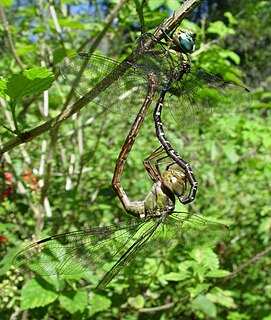
Triacanthagyna is a genus of dragonflies in the family Aeshnidae. The species have large eyes and broad wings. The females have three prominent spines under the last abdominal segment which gives the genus its name. They are commonly known as three-spined darners.

Spinaeschna is a genus of dragonflies in the family Telephlebiidae. These dragonflies are endemic to eastern Australia, where they inhabit streams and rivers.
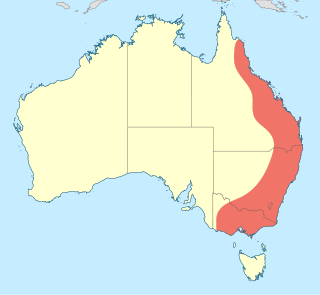
Telephlebia is a genus of dragonflies in the family Telephlebiidae, endemic to eastern Australia. Species of Telephlebia are medium to large, dark chestnut brown dragonflies with dark markings on the leading edge of their wings. They are crepuscular and fly at dusk.



















